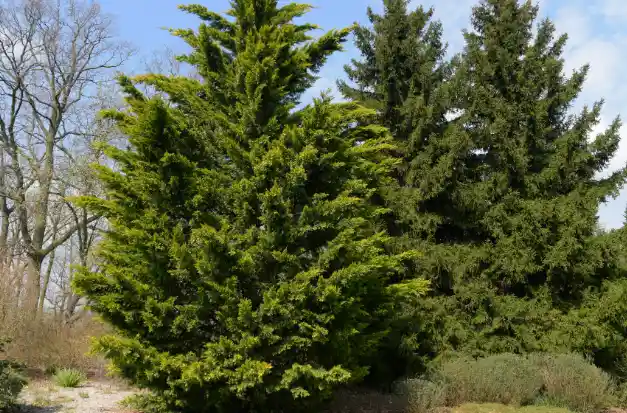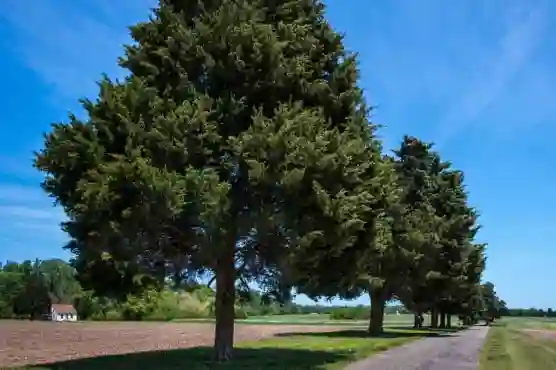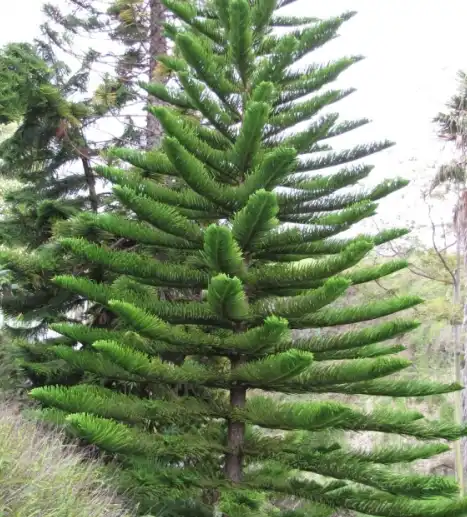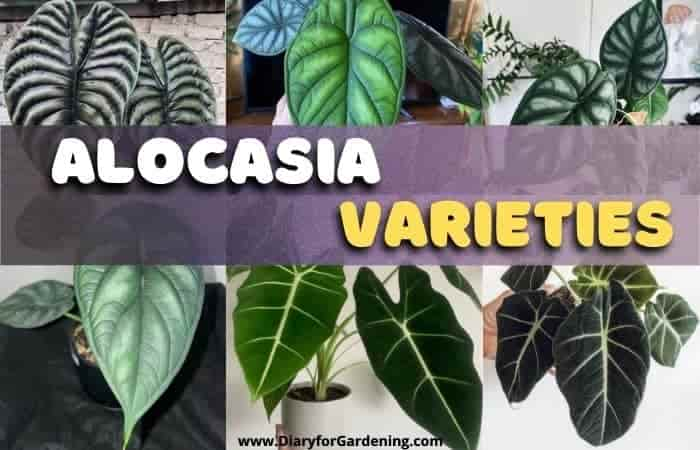12 Gorgeous trees with thin needle-like leaves
Many people are interested in the different shapes of leaves among which needle-like leaves are extra appealing. Are you one of them who is interested in these types of leaves?
Trees with thin needle-like leaves are found in the conifer genus. That’s why they are known as coniferous plants. Most of them are evergreen. Such as pines, fir, spruce, larch, cedar, cypress, juniper, hemlock, araucaria, Sciadopitys, Japanese plum yew and Douglas fir.
If you want to know more detailed information about them, then you are at the right place. Scroll below and get the information about them. You will get their growing areas, types, heights, flowers, seeds, barks and uses here.

12 Trees With Thin Needle-Like Leaves
Now, this is the most significant part of our article where you will get the information about these 12 types of plants.
Pines
If you want to list down the names of the plants which have needle-like leaves, I think the first name will appear of pine trees. Since it is called the largest conifer family.
These plants have their origin in the northern hemisphere, to explain more clearly, in North America. The smallest pine type is enlisted as Siberian dwarf pine and the tallest one is ponderosa pine.
Specifications
- Family- Pinaceae
- Plant height- 3 to 80 meters
- Plant type- Evergreen and resinous tree
- Bark- Thick and scaly
- Leaves- 4 types of leaves are found in pines. Starting from seed leaves this transition ends in matured leaves called needles.
- Flower- Monoecious plant having male and female flowers in the same plant. The flowers are known as conifers.
- Fruit- After fertilization fruits are formed that produce seeds
- Seed- Small, winged and wind-dispersed
- Spreading system- By seeds, new plants are borne.
- Growing area- Different types of areas like rainforest, desert, temperate, subtropical, sub-arid etc.
- Uses- Used in indoor drywall farming, turpentine industry, ornamental purpose, making needle baskets etc.

Fir
After the pines, we will discuss the firs. Firs, also known as abies, is a genus having trees consisting of needle-like leaves.
It originated in Central America and is widely found in Europe, North America and Asia. You may also know it as Old Danish, fyr, fyri, old norse etc.
Specifications
- Family- Pinaceae
- Plant height- 10-80 meters
- Trunk diameter- 0.5 to 4 meters
- Plant type- Evergreen
- Bark- Greyish and cubed
- Leaves- Upper sides of the leaves are green and two whitish stripes are present on the lower sides of the leaves.
- Flower- Flowers or matured catkins are normally brown and immature cones are purple-bluish.
- Fruit- Cones give born to mature fruits
- Seed- Brownish-colored
- Spreading system- By seeds
- Growing area- Mostly in mountainous regions of Asia, Europe and America.
- Uses- Used as timber, for construction purposes,

Spruce
Next, our topic is a spruce tree. Scientists first found them in the northern temperate and boreal regions. It can be of different types like Norway spruce, red spruce, white spruce, black spruce etc.
Specifications
- Family- Pinaceae
- Plant height- 20 to 60 meters
- Plant type- Evergreen
- Bark- Greyish-brown and thin bark
- Leaves- Leaves are spirally arranged
- Flower- Male and female flowers both are present in the same plant. Male flowers are reddish but turn into yellow when matured and female flowers are purple
- Seed- Triangular seed
- Spreading system- By seed
- Growing area- Temperate region
- Uses- Timber yielding plant, making for sounding boards in piano.

Larch
The larch tree is a beautiful tree that originated in Germany, Austria and Switzerland. You may find European larch trees or American larch trees.
Specifications
- Family- Pinaceae
- Plant height- 20 to 60 meters
- Plant type- Deciduous conifer
- Bark- Salmon-pink heartwood and yellowish sapwood.
- Leaves- Needle-like leaves are arranged on long shoots of 50-60 cm
- Flower- Male flower is known as strobili and develops downwards. Again, female flowers are red-colored and go upwards.
- Seed- Winged seeds
- Spreading system- By seed
- Growing area- Widely found in temperate countries like Siberia and Canada
- Uses- Renowned for forestry plantation

Cedar
Cedar is a common plant genus that is taxonomically known as Cedrus. It was first invented in the Mediterranean region and the Himalayas.
Specifications
- Family- Pinaceae
- Plant height- 30 to 40 meters
- Plant type- Evergreen to semi-deciduous
- Bark- Thick ridged barks having scents.
- Leaves- Needle-like leaves that are 8-60 mm long.
- Flower- White-colored flowers
- Seed- 10 to 15 mm long-winged seeds
- Spreading system- By seed
- Growing Area- Tropical
- Uses- Ornamental tree, supplies cedar oil etc.

Cypress
After the cedar, we want to tell you something about the cypress plants. They are from the northern region. African cypress, Chinese-swamp region, false cypress, Fujian cypress etc. are the types of cypress plants.
Specifications
- Family- Cupressaceae
- Plant height- Up to 35 meters
- Plant type- Evergreen coniferous
- Bark- Brownish barks
- Leaves- Dark green leaves 2-5 mm long
- Flower- Bright red star-shaped flowers
- Seed- Greyish small seeds
- Spreading system- Seeds
- Growing area- Temperate region
- Uses- Ornamental purpose, helps to retain the moisture of that atmosphere where they remain.

Juniper
Juniper was first found in central America but now it has spread worldwide including Asia, Africa, other parts of America etc.
Specifications
- Family- Cupressaceae
- Plant height- 20 to 40 meters
- Plant type- Evergreen
- Bark- Brown-squared bark
- Leaves- Needle-like leaves of 5-25 mm
- Flower- Monoecious or dioecious
- Fruit- Berry-like fruits
- Seed- Hard-shelled and unwinged trees
- Spreading system- By seeds or cuttings
- Growing area- Northern temperate region
- Uses- Making of hunting bows and juniper berries are used for culinary purposes.

Hemlock
Originating from America, hemlock is now well-spread in Asia too. Among the 10 species of hemlock, around 4 are found in America and the rest of the 6 are found in Eastern Asia, especially Japan.
Specifications
- Family- Pinaceae
- Plant height- 10 to 60 meters.
- Plant type- Evergreen
- Bark- Grey to brown-colored and furrowed.
- Leaves- Slightly angular of 5 to 35 mm
- Flower- Yellowish-white flowers
- Seed- Globose seeds
- Spreading system- By seed or cuttings
- Growing area- Cool temperate region where they need not face any moisture stress.
- Uses- Wood is used in industries, tanning leather

Japanese Plum Yew
Cephalotaxus harringtonii, commonly known as Japanese plum or cow tail plum, is a comparatively small shrub compared to the others. As you can get an idea from the name, this plant is native to Japan.
Specifications
- Family- Taxaceae
- Plant height- 2 to 3 feet
- Plant type- Evergreen shrub
- Bark- Grey-colored bark
- Leaves- Leaves are almost 5 cm long.
- Flower- Dioecious
- Fruit- Obovoid shaped
- Spreading system- Stem cutting
- Growing area- Japan and many other western countries
- Uses- Used as a foundation plant, border plant or mass plantings.

Araucaria
Araucaria is a common plant all over the world. Native to the American region, this has spread its area to many parts of the world. In some regions, they are familiar with monkey puzzles.
Specifications
- Family- Araucariaceae
- Plant height- 5 to 80 meters
- Plant type- Evergreen coniferous tree
- Bark- Greyish
- Leaves- Needle-like small leaves
- Flower- Dioecious or monoecious
- Seed- Large edible seeds
- Spreading system- By seeds
- Growing area- Humid places
- Uses- Araucaria nuts are used as food, and neuro-protective medicines are made by them

Sciadopitys
The scientific name of Sciadopitys is Sciadopitys verticillata which is native to Japan. It is called a living fossil.
Specifications
- Family- Sciadopityaceae
- Plant height- 15-27 meters
- Plant type- Evergreen coniferous plant
- Bark- reddish-brown color bark which is soft
- Leaves- 7 to 12 cm long shoots
- Flower- Pink-colored flowers
- Seed- Brownish-colored seeds
- Spreading system- By seeds
- Growing area- Temperate regions
- Uses- oil secreted from the bark used for varnishes and dyes.

Douglas firs
Pseudotsuga menziesii, well-known as douglas fir, consist of 3 varieties. They are- coast douglas-fir, Mexican douglas-fir and rocky mountain douglas-fir. Somebody calls it a false hemlock. This plant is rewarded as the king of the Pacific coast forest.
Specifications
- Family- Pinaceae
- Plant height- 20 to 100 meters
- Plant type- Evergreen conifer
- Bark- Thin barks are found in the young trees and the barks of matured plants are thick.
- Leaves- Needles are of 2-4 cm
- Flower- Pinkish flowers
- Fruit- Strobile which are 4-6 inches long and reddish
- Seed- Brownish seeds having single wings.
- Spreading system- By seed
- Growing area- Found mainly in the coastal regions spread from British Columbia to central California.
- Uses- Bark, pines and resins are used for preparing herbal treatments.

Why Do Plants Produce Needle-Like Shape Leaves?
The plants which need to reduce their transpiration rate for environmental purposes produce needle-like leaves. In this case, they need to reduce transpiration or water loss due to two purposes.
Conifer plants are dominant in cool areas. As a result, they don’t get excessive sunlight for their development. Consequently, they cannot produce an excess amount of food for their survival as plants have normal leaves.
Besides, if any conifer is somehow born in semi-arid land, they cannot get even enough water which they can use for their growth. Besides, water is drastically released outside by their leaves.
Due to these facts, needle-like leaves are formed which reduces the water loss. At the same time, as their leaves are spread throughout the whole shoot, they can produce food from all of the parts of the shoots.
Thus, the food production and water loss system is balanced and coniferous plants can survive in adverse conditions.
FAQs
1. Why are those leaves called needle-like?
Because these leaves are so slender or narrow that they look like a needle. All of the leaves are of such kinds that their leaves don’t grow much in width.
2. What forests have needle-like leaves?
Coniferous forest is the place where you may find plants consisting of needle-like leaves. This vegetation is normally grown in temperate regions with high rainfall.
3. What is the benefit of a need-like leaf surface?
Such leaves reduce the transpiration rate. As a result, they don’t need to take much food for their survival and they may easily go through adverse conditions.
4. Are needle-like leaves and scale-like leaves the same?
No. They are different from each other. Needle-like leaves are narrow and have pointed edges. On the contrary, scale-like leaves are fleshy and can retain water inside them.
Final Thoughts
So, finally, we are at the ending point of our discussion. The structure of trees with thin needle-like leaves is adorable for their long shoots with narrow foliage. As most of the leaves are dark green, they seem to create a mysterious look.
If you want to plant a conifer plant in your house areas, you can easily pick one of them for planting. You just have to take care of them in their initial stage. Later they will grow at their energy and will provide you with a shady sitting place inside your yard.






